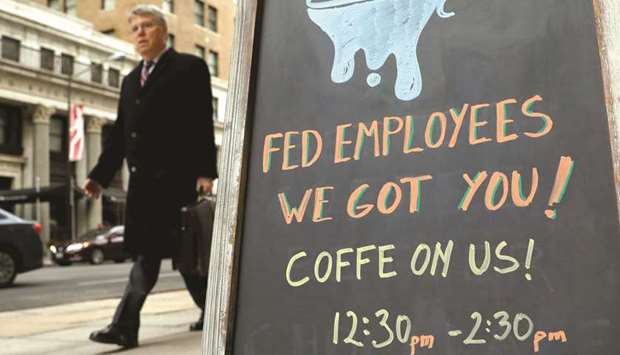US
Democrats yesterday agreed to support a temporary funding bill to end a
partial shutdown of the federal government, now in its third day, as a
key vote began in the Senate.
The Senate’s top Democrat Chuck Schumer
told the chamber he had reached a deal with Majority Leader Mitch
McConnell — in exchange for a pledge to address Democrat concerns over
hundreds of thousands of immigrants brought to the country as children.
Democrats
had refused to vote for the temporary budget extension unless they
secured guarantees on the future of the so-called “Dreamers,” who will
be vulnerable to deportation when the DACA programme protecting them
expires in March.
“After several discussions, offers, counteroffers,
the Republican leader and I have come to an arrangement,” Schumer said,
moments before the key vote got underway.
“We will vote today to
reopen the government to continue negotiating a global agreement with
the commitment that if an agreement isn’t reached by February 8, the
Senate will immediately proceed to consideration of legislation dealing
with DACA,” he said.
The bill to keep government funded through
February 8 requires 60 votes to advance in the 100-member Senate,
meaning Republicans — who have a one-seat majority — need to lure
several Democrats to their side.
If the bill clears the Senate, it
will still have to go back to the House of Representatives, since the
text has been modified since the lower chamber adopted it last Friday.
Hundreds
of thousands of US federal employees were forced to stay home without
pay yesterday after lawmakers failed to reach an agreement on ending a
government shutdown before the start of the work week.
Meanwhile, the
Statue of Liberty reopened yesterday after New York Governor Andrew
Cuomo on Sunday vowed to use state funds to keep the landmark monument
in operation.
Dozens of other national parks and monuments were
partially or entirely closed after Congress failed to agree on a
spending plan to keep the government running past a Friday midnight
deadline.
In the hours leading up to the shutdown, the Trump
administration worked on ways to keep hundreds of parks open without
staff in an effort to avoid public anger, although it was unclear which
ones would close.
“Not all parks are fully open but we are all
working hard to make as many areas as accessible to the public as
possible,” US Interior Secretary Ryan Zinke said on Twitter on Saturday.
The
hit-or-miss closures forced tourists and residents alike to alter their
plans. In lower Manhattan, where ferries normally embark for the Statue
of Liberty in New York Harbor, out-of-town visitors expressed
frustration that the site was closed.
And San Diego Police Chief Shelley Zimmerman posted a photo of a “closed” sign outside Cabrillo National Monument on Twitter.
“I
had planned to do some tide pool repeats to get some hill work in on my
bicycle ride this morning,” she wrote, referring to a local bike route.
“Change of plans.”
The National Parks Conservation Association, an
advocacy group, estimated that one-third of the 417 national park sites
were shuttered, “including places like the Statue of Liberty,
presidential homes, and other historic and cultural sites primarily made
up of buildings that can be locked.”
Yellowstone National Park, a
9,065sq km wilderness located mostly in Wyoming, remained open but
offered limited services, with visitor centres closed and park rangers
absent.
The association warned that the lack of staff could pose dangers to visitors.
Xanterra
Parks & Resorts, a private company that manages lodges, concessions
and restaurants in numerous national parks including Yellowstone, Grand
Canyon, Mount Rushmore, Rocky Mountain and Zion, said they will remain
open during the shutdown.
In Washington, the Smithsonian museums and the National Zoo opened yesterday, using prior-year funds.
But in Philadelphia, visitors were turned away at the Liberty Bell.
During
the last shutdown in 2013, a number of governors used state funds to
keep parks open, including the Statue of Liberty, which at the time cost
$61,600 per day to reopen.
At a news conference at the Statue of
Liberty, Cuomo said the site generates tourism revenue, adding that the
monument serves as a welcoming beacon to immigrants arriving in the
United States.
“We don’t want to lose the income,” he said. “And
symbolically, you can shut down the government, but you can’t shut down
the Statue of Liberty.”
In Arizona, Republican Governor Doug Ducey
committed state funds to keep the Grand Canyon open, including trash
removal, snow ploughing and public restrooms, according to Ducey
spokesman Patrick Ptak.
“We recognise it’s a huge economic attractor
and has a big impact not just on rural areas around the Grand Canyon but
the state as a whole,” Ptak said, adding that the expected cost is
around $100,000 per week.
But in South Dakota, home of Mount
Rushmore, Republican Governor Dennis Daugaard has said he would not take
any action to keep the monument open during a shutdown.

A worker passes a cafe offering free coffee to federal employees near the White House in Washington yesterday morning.


